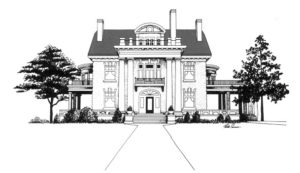Established in 1969 and honored in 2009 with the Texas Historical Commission’s Governor’s Award in Preservation, Historic Fort Worth, Inc. is dedicated to preserving Fort Worth’s unique historic identity through stewardship, education and leadership. HFW stewards two historic house museums for the public’s enrichment, the 1904 Wharton-Scott House known as Thistle Hill and the 1899 Ball-Education-McFarland House, Fort Worth’s first and second landmarks, respectively.
HFW’s administrative offices are located on the second floor of McFarland House, 1110 Penn Street. The main floor serves as a historic house museum, and the lower level is a resource library comprised of books, photographs, surveys and thousands of files on historic buildings in Fort Worth. McFarland House is available to the public for tours, rentals and research.
Other HFW programs include membership tours of private and public buildings, programs on restoration and property management, historic property research, marketing of endangered buildings, preservation courses for developers and Realtors, awards, tours of the city for special conferences, survey updates, and facade easements. Additionally, HFW works behind the scenes and at public meetings to create opportunities for those places that matter most to Fort Worth’s unique historic identity.
Friends and constituents connect with HFW through memberships, community programs, as tourists, and at fundraisers like Preservation is the Art of the City®, the Hidden Gardens Tour of Fort worth, A Needlepoint Love Story, the Rodeo Run and holiday events. HFW is a 501(c)(3) charity and memberships are available on the website.
At times HFW leverages unique opportunities to further its mission. Examples follow:
- Organized and led tours and sessions for the 6th Art Deco World Pre-Congress in 1999.
- Worked with Mistletoe Heights on the establishment of their local historic district (2001-2002).
- Served as the lead manager of the National Town Meeting on Main Street (2002)
- Organized and managed the Your Town: Citizens’ Institute on Rural Design (2007) through a grant from the National Endowment for the Arts, SUNY University and the Carl Small Town Center.
- Helped to designate the Near Southeast Neighborhood to establish their local district (2007).
- Launched Fort Worth’s first local electronic survey of historic resources (2008) with over 500 properties.
- Funded the nomination (2009) for Heritage Park Plaza to be included in the National Register of Historic Places, which occurred at the national level of significance on May 10, 2010.
- Held a 2010 showcase in a mid-century modern masterpiece, the estate of Fran & Eddie Chiles.
- Leveraged opportunities for the Ridglea Theater and offices to be designated a local landmark, which transpired in January 2011, and to be listed in the National Register, which transpired in January 2012.
- Defended the city of Fort Worth’s Landmarks ordinance in 2013.
- In 2016 raised the funds to produce an intensive level survey of the stockyards.
Thistle Hill (Wharton-Scott House) 1509 Pennsylvania Avenue:
Built in 1903-04, Thistle Hill was designated in 1978 as the first City of Fort Worth landmark. A rare Georgian Revival mansion in a neighborhood once known as Quality Hill, Thistle Hill epitomizes the architectural grandeur of the cattle barons. Albert Buckman Wharton, Jr. and Electra Waggoner Wharton, the daughter of wealthy pioneer cattleman W.T. Waggoner, moved into this 11,000 square foot, 18-room mansion in 1904. Originally designed by Sanguinet and Staats, the house was redesigned by the same firm in 1911 when the mansion was purchased in 1910 for $90,000 by Elizabeth and Winfield Scott. In 2022 HFW conveyed stewardship of Thistle Hill to Cooks Children’s.
Ball-Eddleman-McFarland House at 1110 Penn Street
Built in 1899 and designated a City of Fort Worth Landmark in 1980, McFarland House was Fort Worth’s second property to achieve local landmark status. Known as the region’s most intact Queen Anne residence, the elegant Ball-Eddleman-McFarland House was built high on a bluff overlooking the Trinity River. This sophisticated Victorian beauty of a little over 5,000 square feet was designed in 1899 by English architect Howard Messer for Galveston widow Mrs. George Ball (Sarah) and her son Frank. The house cost $38,000 to build at a time when the average cost of a home was $2,000 to $4,000. The second owners, William and Sarah Conger Eddleman, were from Weatherford. They bough the house in 1904, and moved in with their daughter and her husband, Caroline (Carrie) Aurelia and Frank Hays McFarland. Carrie McFarland lived there until her death in 1978 at the age of 100.
Examples of unique buildings and structures HFW has assisted:
- Knights of Pythias Hall, 900 E 2nd Street 1928
- Max Mehl Building, 1228 S Henderson Street 1816
- Tandy Wire & Cable, 3500 McCart Avenue 1924
- Swift & Company Office Building, 600 E Exchange Avenue 1902
- Forest Park Gates, 2300 Block Park Place Avenue, 1917-1918
- Heritage Park Plaza, Bluff Street at Houston Street, 1976
- Inspiration Point Shelter, 2300-2500 Roberts Cut-Off Road, 1930s
- Ridglea Theater, Camp Bowie Boulevard, 6025 Camp Bowie Blvd. 1950
- Tarrant County Medical Society Building, 3855 Tulsa Way, 1945
- Getzendanner House, 760 Samuels Avenue, 1890s
- Fuller House, 4161 Charron Lane, 1953
- Chase Court Hemphill Street at Chase Court, 1906
- Meissner Brown Funeral Home, 2717 Avenue B, 1937
- Fort Worth Public Market, 1400 Henderson St.
- Kimbell Milling Co. building, 2109 S. Main St.


